My second regiment from HaT’s Napoleonic Swedish Cavalry is The King’s Horse Guard (Konungens Livgardet till häst). The box contains just the 1 pose of this regiment, reproduced in 3 figures which I’ve doubled up via the purchase of an extra box. So it’s not so much a regiment, as a squadron – but enough to guard a Crown Prince at any rate!
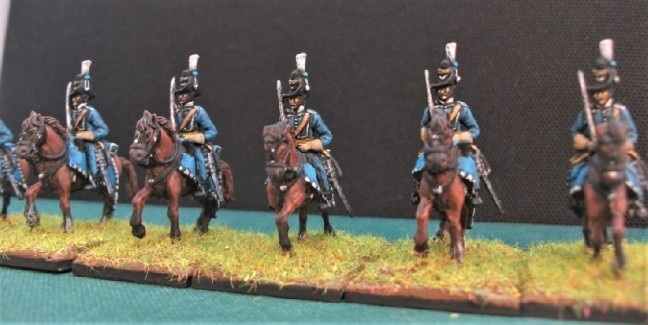
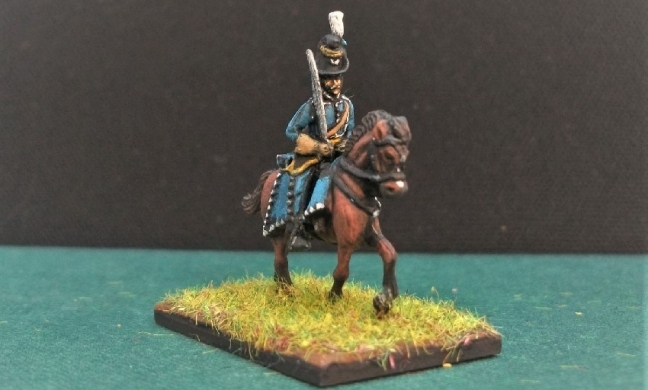
Their horses are a chestnut-coloured selection of Swedish Warmbloods, a breed used by today’s successor regiment to the Livgardet till häst in ceremonial duties. In Napoleonic times, any reasonable pony often would have had to suffice but I’ve been generous to this exclusive guard detachment and referenced their modern equivalents with this colour of mount.
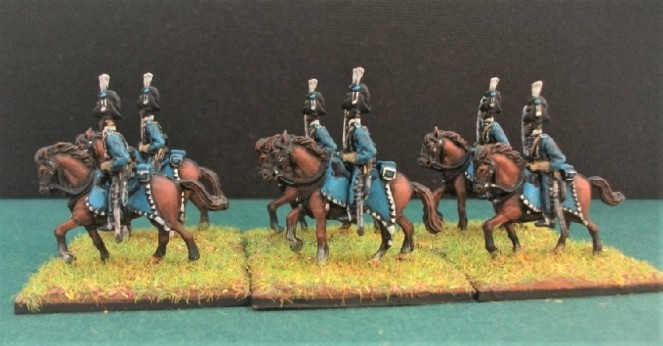
Having the same pose is not a problem with this group, I think. With swords drawn and advancing calmly at the walk, they look entirely like a guard regiment out on royal duty or parade. A more energetic action pose would have been less appropriate for these royal dandies.
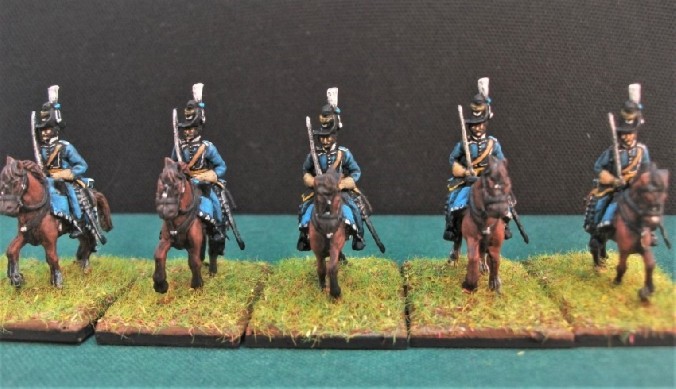
The unusual mid-light blue uniform (I’ve used Vallejo Andrea Blue) and distinctive headgear with white plume and facings make them a decorative addition to my project. It seems that selecting a shade of blue wasn’t just a problem for me. Regarding the modern regiment, Wikipedia says that;
The colour of the parade uniform worn by the cavalry was in the 1950s changed to match the officer’s “mid-blue” shade: (a slightly lighter colour) for all ranks. In the 1990s, the colour was again changed, apparently in error, to a royal blue colour. The shade for other ranks is now to revert to mid-blue, while officers will retain “middle blue, slightly lighter.”
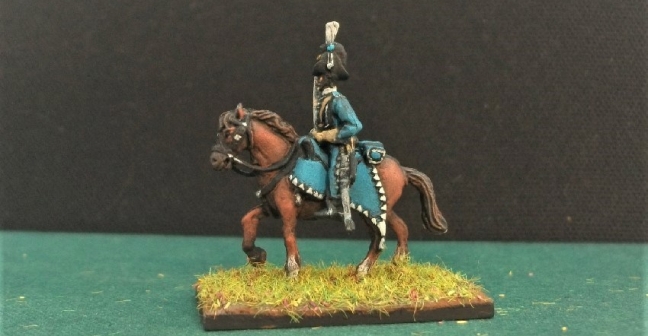
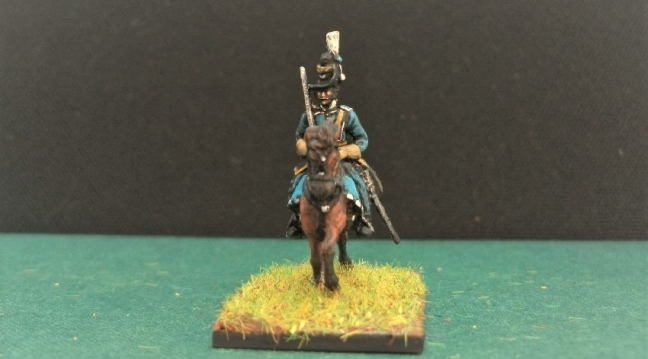
Before the regimental biography commences, I perhaps ought to ponder on which regiment to tackle next in the project. I’m determined to clear the box (at least at some point) and there are three regiments remaining: the Småland Light Dragoons, the Scanian Carabiniers, and the Skjöldebrand Cuirassiers. All look quite interesting… but I’ve randomly chosen the Småland Light Dragoons to be the 29th regiment in the project!
Biography: The King’s Horse Guard [Sweden]

HaT’s own website contains a great overview of the Swedish cavalry during Napoleonic times including an extensive section by Björn Bergérus on the Horse Guards which I respectfully reproduce below.
Taken from an original text by Björn Bergérus, Stockholm, Sweden 2005-2006.
This unit originated in Finland (based in Borgå/Porvoo, very close to Helsinki). The unit was promoted to Guards’ status – Lätta dragonerna av Livgardet (The Light Dragoons of the Life Guards) – after the bloodless coup d’état of the Swedish king Gustavus III. In 1793 the unit was renamed Livhusarregementet (The Life Hussar Regiment), and in 1797 Livdragonkåren (The Life Dragoon Corps) and finally got the name Livgardet till häst (The Horse Guards) in 1806.
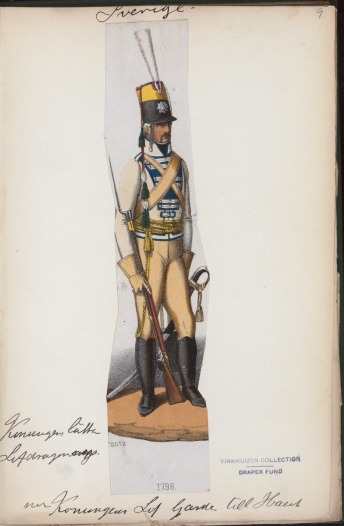
The unit was composed of three companies (later called squadrons) of 50 men each. When inspected in 1771 the commander found “that all dragoons were made up of Swedish or Finnish, all happy, well spirited and particularly beautiful people”.
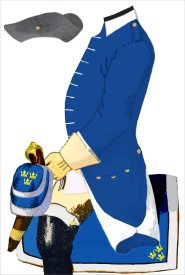
In the bloodless coup d’état by Gustavus III in 1772, the unit’s commander Jakob Magnus Sprengtporten took a force of some 1.000 men and sailed to Stockholm from Finland to support the king. Due to poor winds, however, he arrived only some two weeks after the successful coup d’état. The king was nevertheless very grateful and made 100 men of the unit into the King’s personal bodyguard to reside in the capital of Stockholm. Sprengtporten was also made the commander of both the Foot and Cavalry Guards. The new guard unit was given the name Lätta dragonerna av livgardet – the Light Dragoons of the Lifeguard. History tells that the old guard regiments – the Life Regiment and the Foot Guards – found it hard to regard the dragoons as their equals with resulting petty disputes between officers and even coming to blows between the troopers.
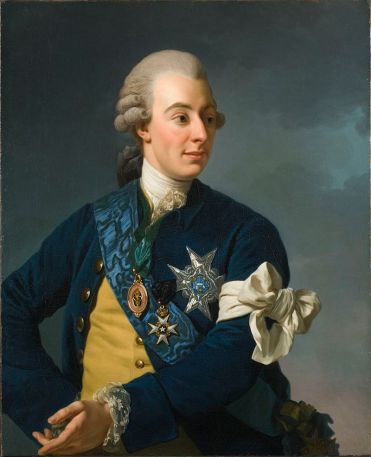
In 1777 the two parts of the regiment – in Sweden and Finland respectively – were amalgamated to the Stockholm area, counting four squadrons of 200 men total. In 1793 the name was changed to Livhusarregementet – the Life Hussar Regiment. At the end of the 1790s the unit was reduced to two squadrons and the name changed to Lätta livdragonregementet – the Light Life Dragoon Regiment.

About 90 troopers from the regiment were present during the campaign in and around Swedish Pomerania (North Germany) against the French in 1805-07. The campaign was fruitless, as the troops eventually had to retire before a more numerous French foe. The commander Löwenhjelm and four troopers still got medals for bravery for a delaying action during a crossing of the river Elbe.
The regiment’s name was changed again in 1806 to Konungens lifgarde till häst – the King’s Horse Guard – or simply the Horse Guards.
The regiment also fought in the Russo-Swedish war of 1808-09. One squadron took part in a landing operation against Turko/Åbo that resulted in hard fighting that is said to have lasted for 14 hours. The commander von Vegesack writes of the Horse Guard that they “fought as a guard should fight; they have with the greatest manly courage endured the renewed attacks of the enemy and never fallen back a single step”. Many troopers were mentioned for their good conduct during this battle, like trooper no. 4 Lind, who had “shot nine Russians, and freed himself and five men of the militia from captivity”.
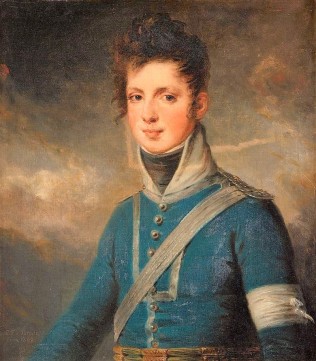
Later during the summer of 1808 a new landing attempt was made to cut off the Russian supply from their bases in the south of Finland. Three reduced infantry regiments, a battery of guns and two squadrons of Horse Guard took part. The landing force was soon engaged by the Russians, but could give support to another Swedish brigade at Lappfjärd under the Swedish General von Döbeln (immortalised by the Finnish poet Johan Ludvig Runeberg). After a successful engagement the Horse Guard could pursue the fleeing Russians. Von Vegesack then joined the main army and took part in the battle of Oravais close to Vaasa in Western Finland September 14th 1808. Here some 5-6.000 Swedes-Finns faced some 6-7.000 Russians – the only major battle of the Russo-Swedish war 1808-09. At first it looked good for the Swedish-Finnish, but the battle finally ended in a Russian victory.
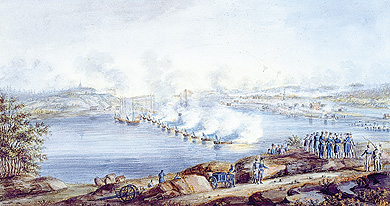
During the winter of 1808-09 four squadrons of the Horse Guard were stationed on the Åland Islands, between the Finnish and Swedish mainland. Here several small skirmishes took place with Russian Cossacks – often on the frozen ice between the small islands. During one of these events, a trooper named Kämpe of the Horse Guards (Kämpe meaning ‘fighter’ in Swedish – soldiers were often given these short “soldiers’ names” that were easy to remember) is recorded to have cut one Cossack in the throat and broke his lance. The Swedish defenders were eventually forced to retreat over the frozen waters from Åland to the Swedish mainland before the advance of more numerous Russians. The Horse Guards covered the retreat, and was engaged several times in small skirmishes with harassing Russian Cossacks.
In August 1809 a final Swedish push was made with a landing designed to take back the town of Umeå on the Swedish mainland. The Swedish force was composed of 7.000 men, more numerous than the defending Russians. Two squadrons of the Horse Guards were present, although fighting on foot. The Swedish command was as slow and hesitant, as the Russian commander Kamenski was eager and determined. The Swedish suffered from not having mounted cavalry as scouts and overestimated – as usual – the strength of the Russians. After some fighting the Swedish chose to retire and re-embark – the landing having been a failure. Five troopers of the horse guards nevertheless got medals for bravery.
With the peace in 1809 Finland was lost to Russia and made into a Grand Duchy under the Russian Tsar. A total of 24 medals of honour had been awarded to the men from the Horse Guard during the war.
The regiment was seriously decimated by the war – upon inspection the regiment had 95 horses present of which 34 were rejected for further service and about the rest they were said to be “very poor, due to serious fatigue, cold and – for the horse’s maintenance during the end of the campaign – a far too inadequate supply of food”.
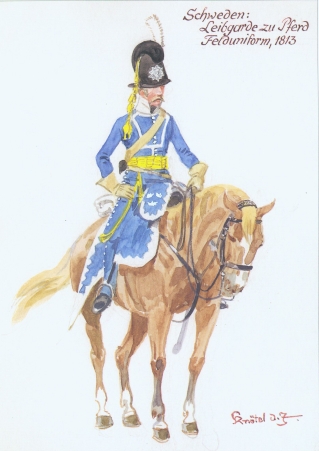
During the campaigns of 1813-14 the Horse Guard mainly served as escort and bodyguard to the newly elected Crown Prince of Sweden, the former French Marshal Bernadotte, now commander of the allied Army of the North. The Horse Guard also functioned as a recruiting base for dispatch riders. In Germany the regiment also got new beautiful light blue hussar uniforms made up by the fine tailors of Berlin.
After the short war with Norway in 1814 the Horse Guards were stationed in Fredrikshald, Norway, for some two months together with other Swedish troops to guarantee the peace treaty, in which Norway accepted Bernadotte as their king, joining a union with Sweden that lasted until 1905.
Notable campaigns: Swedish Pomerania (1805-07), Russo-Swedish war of 1808-09, War of the Sixth Coalition (1813-14).
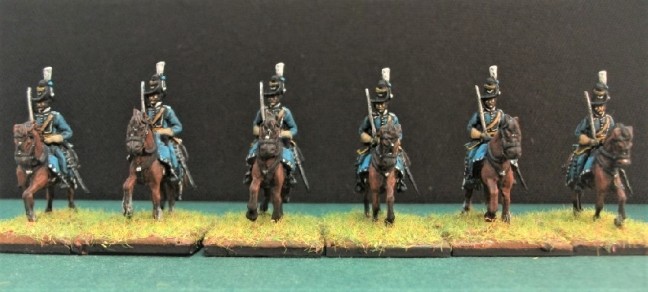


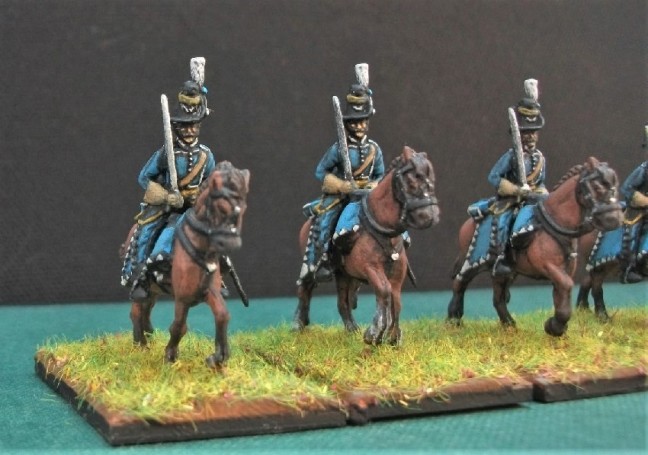





The horse colours and blues are well done and it is an impressive unit. I would suggest to add the odd branch, stone or bush to the bases to add some interest, but overall a beautiful addition to your gaming table.
LikeLiked by 1 person
Thanks! I think you’re right about the base. I’ve been a bit lazy with them but I may well go back and add a little extra detail.
Cheers
Marvin
LikeLiked by 1 person